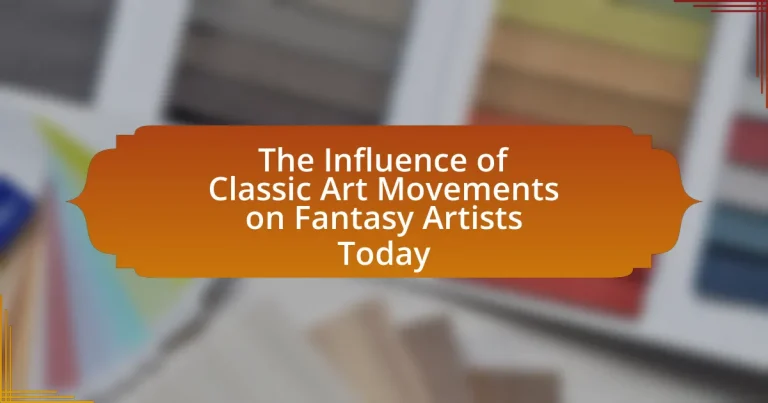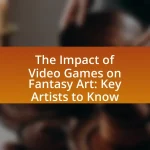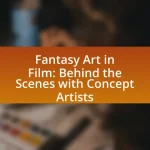The article examines the influence of classic art movements on contemporary fantasy artists, highlighting key movements such as Romanticism, Surrealism, and Baroque. It discusses how these movements provide foundational techniques and thematic inspiration, shaping the visual and narrative aspects of modern fantasy art. The Renaissance’s impact on techniques like linear perspective and chiaroscuro is explored, along with the emotional depth derived from Romantic ideals and the imaginative elements introduced by Surrealism. Additionally, the article addresses the challenges artists face in balancing originality with homage to classic styles and offers best practices that can enhance contemporary fantasy artwork.
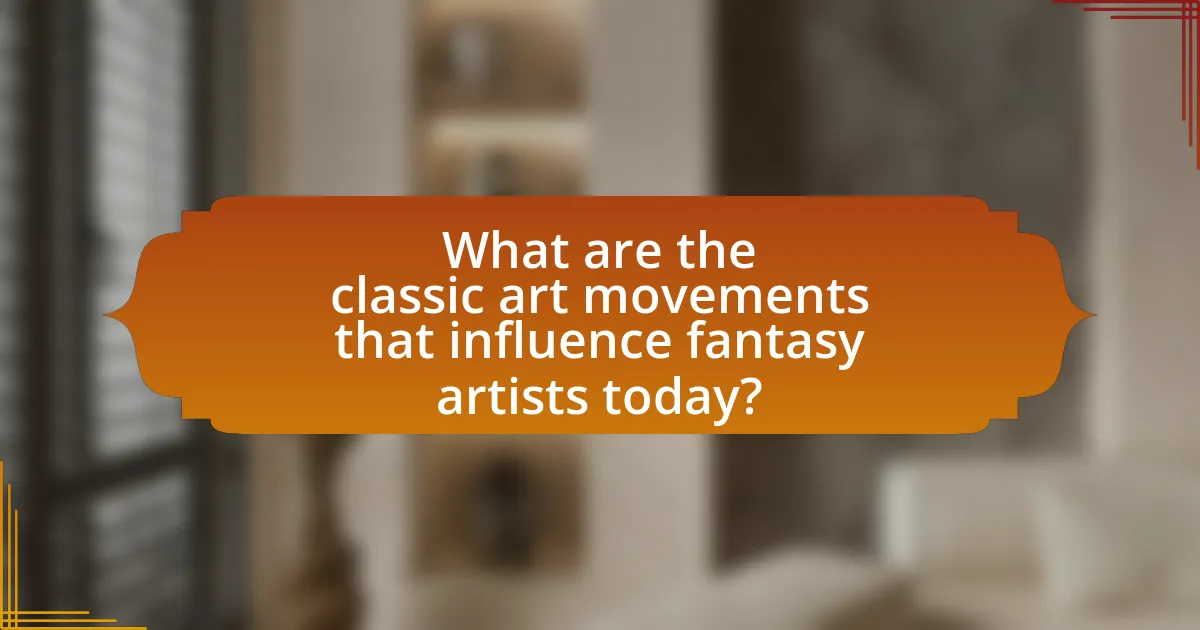
What are the classic art movements that influence fantasy artists today?
Classic art movements that influence fantasy artists today include Romanticism, Surrealism, and Baroque. Romanticism, characterized by its emphasis on emotion and nature, inspires fantasy artists to create evocative landscapes and dramatic scenes. Surrealism, with its dream-like imagery and exploration of the subconscious, encourages fantasy artists to incorporate bizarre and imaginative elements into their work. Baroque art, known for its grandeur and dynamic compositions, influences fantasy artists in their use of light, shadow, and intricate details to create a sense of depth and movement. These movements provide foundational techniques and thematic inspiration that continue to shape contemporary fantasy art.
How did the Renaissance shape modern fantasy art?
The Renaissance significantly shaped modern fantasy art by introducing techniques such as linear perspective, chiaroscuro, and a focus on human anatomy, which artists continue to utilize today. This period emphasized realism and the exploration of human emotion, leading to a more dynamic representation of characters and scenes in fantasy art. For instance, the use of perspective allows artists to create immersive worlds, while chiaroscuro enhances the dramatic effect of light and shadow, as seen in the works of Leonardo da Vinci and Michelangelo. These foundational techniques have been adopted and adapted by contemporary fantasy artists, enabling them to create visually compelling narratives that resonate with audiences.
What techniques from the Renaissance are still used by fantasy artists?
Renaissance techniques such as chiaroscuro, linear perspective, and anatomical accuracy are still utilized by fantasy artists today. Chiaroscuro, the use of strong contrasts between light and dark, enhances the dramatic effect in fantasy illustrations, allowing artists to create depth and volume. Linear perspective, which involves creating the illusion of depth on a flat surface, helps fantasy artists construct believable environments, making scenes more immersive. Additionally, anatomical accuracy, emphasized during the Renaissance, aids artists in depicting fantastical creatures and characters with realistic proportions, contributing to the overall credibility of their imaginative works. These techniques have been foundational in art history and continue to influence contemporary fantasy art, demonstrating the lasting impact of Renaissance principles.
How did Renaissance themes influence fantasy narratives?
Renaissance themes significantly influenced fantasy narratives by introducing concepts of humanism, individualism, and a renewed interest in classical mythology. These themes encouraged writers and artists to explore complex characters and intricate worlds, reflecting the human experience and emotions. For instance, the emphasis on realism and perspective in Renaissance art inspired fantasy creators to develop more immersive and believable settings, as seen in works like J.R.R. Tolkien’s “The Lord of the Rings,” which incorporates detailed landscapes and rich histories reminiscent of Renaissance ideals. Additionally, the revival of classical mythology during the Renaissance provided a wealth of archetypes and stories that continue to shape fantasy literature, evident in the incorporation of mythological creatures and heroic quests in contemporary narratives.
What role does Romanticism play in contemporary fantasy art?
Romanticism significantly influences contemporary fantasy art by emphasizing emotion, individualism, and the sublime. This movement, which emerged in the late 18th century, prioritizes personal expression and the exploration of nature’s beauty and terror, elements that are prevalent in modern fantasy artworks. For instance, artists like Brian Froud and Julie Bell incorporate Romantic ideals by depicting fantastical landscapes and characters that evoke deep emotional responses, mirroring the Romantic focus on the sublime. Additionally, the use of dramatic lighting and rich color palettes in contemporary fantasy art reflects the Romantic tradition of enhancing emotional depth, further validating the ongoing impact of Romanticism in shaping the aesthetic and thematic elements of today’s fantasy art.
How do Romantic ideals manifest in fantasy artwork?
Romantic ideals manifest in fantasy artwork through the emphasis on emotion, nature, and the sublime, often depicting fantastical landscapes and heroic figures that evoke a sense of wonder and introspection. Artists like Caspar David Friedrich and J.M.W. Turner, who were pivotal in the Romantic movement, influenced contemporary fantasy artists by showcasing dramatic contrasts in light and shadow, as well as the portrayal of nature as a powerful and emotive force. This connection is evident in modern fantasy artwork, where themes of adventure, the supernatural, and the exploration of the human spirit resonate with the Romantic tradition, reinforcing the idea that art serves as a medium for expressing deep emotional experiences and the beauty of the natural world.
What are the emotional impacts of Romanticism on fantasy themes?
The emotional impacts of Romanticism on fantasy themes include heightened feelings of individualism, nature’s sublime beauty, and the exploration of deep emotions. Romanticism emphasizes personal experience and emotional depth, which influences fantasy narratives to focus on characters’ inner struggles and desires. For instance, the Romantic ideal of the sublime often manifests in fantasy settings that evoke awe and terror, reflecting the complexities of human emotion. This connection is evident in works like J.R.R. Tolkien’s “The Lord of the Rings,” where the vast landscapes and the characters’ emotional journeys resonate with Romantic ideals. Thus, Romanticism significantly shapes the emotional landscape of fantasy themes by prioritizing personal experience and the exploration of profound feelings.
How has Surrealism impacted the imagination of fantasy artists?
Surrealism has profoundly influenced the imagination of fantasy artists by introducing dream-like imagery and unconventional narratives. This movement, which emerged in the early 20th century, encouraged artists to explore the subconscious and depict fantastical scenes that defy logical reasoning. For instance, Salvador Dalí’s melting clocks and René Magritte’s unexpected juxtapositions have inspired contemporary fantasy artists to create works that challenge reality and evoke emotional responses. The incorporation of surreal elements allows fantasy artists to expand their creative boundaries, resulting in unique visual storytelling that captivates audiences.
What elements of Surrealism are prevalent in modern fantasy art?
Modern fantasy art prominently features elements of Surrealism, such as dreamlike imagery, unexpected juxtapositions, and the exploration of the subconscious. These characteristics manifest in the use of bizarre landscapes, distorted figures, and illogical scenes that challenge reality, similar to the works of Surrealist artists like Salvador Dalí and René Magritte. For instance, contemporary fantasy artists often create worlds where the impossible becomes possible, reflecting the Surrealist aim to unlock the imagination and delve into the depths of human experience. This influence is evident in the artwork of creators like Brian Froud and Yoshitaka Amano, who incorporate surreal elements to evoke emotions and provoke thought, aligning with the Surrealist tradition of blending fantasy with psychological exploration.
How do fantasy artists use Surrealism to challenge reality?
Fantasy artists use Surrealism to challenge reality by incorporating dream-like imagery and illogical scenes that defy conventional perceptions. This approach allows them to explore the subconscious, evoke emotions, and present alternative realities that question the nature of existence. For instance, artists like Salvador Dalí and Max Ernst have influenced contemporary fantasy artists by demonstrating how distorted forms and unexpected juxtapositions can create a sense of wonder and provoke thought. The use of surreal elements enables these artists to push boundaries, inviting viewers to reconsider their understanding of reality and imagination.

How do classic art movements inform the techniques of fantasy artists?
Classic art movements inform the techniques of fantasy artists by providing foundational principles of composition, color theory, and thematic exploration. For instance, the use of chiaroscuro from the Baroque period enhances the dramatic lighting in fantasy scenes, while the vibrant color palettes of Impressionism inspire fantasy artists to create immersive worlds. Additionally, the narrative depth found in Romanticism influences the storytelling aspect of fantasy art, encouraging artists to evoke emotion and grandeur in their work. These historical techniques are evident in contemporary fantasy art, where artists often draw upon the stylistic elements of these movements to enrich their visual storytelling and enhance the viewer’s experience.
What specific techniques have been adopted from classic art movements?
Specific techniques adopted from classic art movements include chiaroscuro, which emphasizes the contrast between light and shadow to create depth, and the use of linear perspective, which allows for the depiction of three-dimensional space on a two-dimensional surface. Additionally, the application of color theory, as seen in Impressionism, influences modern fantasy artists in their palette choices. The technique of sfumato, developed during the Renaissance, is also utilized to create soft transitions between colors and tones. These techniques are evident in contemporary works, where artists blend traditional methods with modern themes to enhance visual storytelling.
How do color palettes from classic art influence fantasy illustrations?
Color palettes from classic art significantly influence fantasy illustrations by providing a rich foundation of color theory and emotional resonance. Artists often draw inspiration from the color schemes used by masters like Claude Monet or Vincent van Gogh, who employed specific palettes to evoke mood and atmosphere. For instance, Monet’s use of soft pastels in his Impressionist works creates a sense of tranquility, which fantasy illustrators replicate to evoke similar feelings in their own worlds. Additionally, the bold, contrasting colors found in works of the Baroque period, such as those by Caravaggio, inform the dramatic lighting and vivid color choices in contemporary fantasy art, enhancing the visual storytelling. This connection between classic art and modern fantasy is evident in the way artists utilize historical color palettes to create depth and emotion, thereby enriching the viewer’s experience.
What compositional strategies from classic art are utilized in fantasy art?
Fantasy art utilizes several compositional strategies from classic art, including the use of balance, focal points, and the rule of thirds. Balance in fantasy art often mirrors the symmetrical arrangements found in Renaissance paintings, creating a sense of harmony. Focal points are strategically placed to draw the viewer’s eye, similar to how classic artists like Caravaggio directed attention through light and shadow. The rule of thirds, a technique employed by many classic artists, helps in composing dynamic and engaging scenes in fantasy art, ensuring that key elements are positioned at intersecting points for visual interest. These strategies enhance the storytelling aspect of fantasy art, making it visually compelling and emotionally resonant.
How do classic art movements inspire the themes and subjects in fantasy art?
Classic art movements inspire the themes and subjects in fantasy art by providing foundational aesthetics, techniques, and narrative elements that artists adapt and reinterpret. For instance, the Romantic movement’s emphasis on emotion and the sublime can be seen in fantasy art’s portrayal of epic landscapes and heroic figures, evoking a sense of wonder and adventure. Additionally, the use of chiaroscuro from the Baroque period enhances the dramatic tension in fantasy scenes, while the detailed realism of the Renaissance influences character design and world-building. These historical styles serve as a rich source of inspiration, allowing contemporary fantasy artists to create visually compelling and thematically resonant works that echo the depth and complexity of classic art.
What recurring themes from classic art can be found in fantasy narratives?
Recurring themes from classic art found in fantasy narratives include the exploration of heroism, the interplay between good and evil, and the representation of mythological and allegorical figures. These themes are evident in classic works such as the Renaissance paintings that depict heroic figures and moral dilemmas, which have influenced modern fantasy storytelling. For instance, the use of archetypal heroes in fantasy literature mirrors the heroic representations in classical art, such as those seen in the works of Michelangelo and Raphael. Additionally, the duality of good versus evil, often illustrated in classic art through contrasting colors and forms, is a prevalent theme in fantasy narratives, as seen in the works of J.R.R. Tolkien and C.S. Lewis, who draw heavily on allegorical elements reminiscent of classical traditions.
How do historical contexts of classic art movements shape fantasy storytelling?
Historical contexts of classic art movements significantly shape fantasy storytelling by providing thematic and stylistic frameworks that influence narrative structures and visual representations. For instance, the Romantic movement, characterized by its emphasis on emotion and nature, inspires fantasy narratives that explore the sublime and the mystical, often featuring protagonists who embark on journeys through enchanted landscapes. Additionally, the Baroque period’s dramatic use of light and shadow informs the visual aesthetics of fantasy art, creating a sense of depth and grandeur that enhances storytelling. The Surrealist movement, with its dream-like imagery and exploration of the subconscious, also impacts fantasy by encouraging narratives that blur the lines between reality and imagination. These historical contexts not only enrich the thematic depth of fantasy stories but also guide contemporary artists in their creative processes, ensuring that the legacy of classic art movements continues to resonate in modern fantasy storytelling.
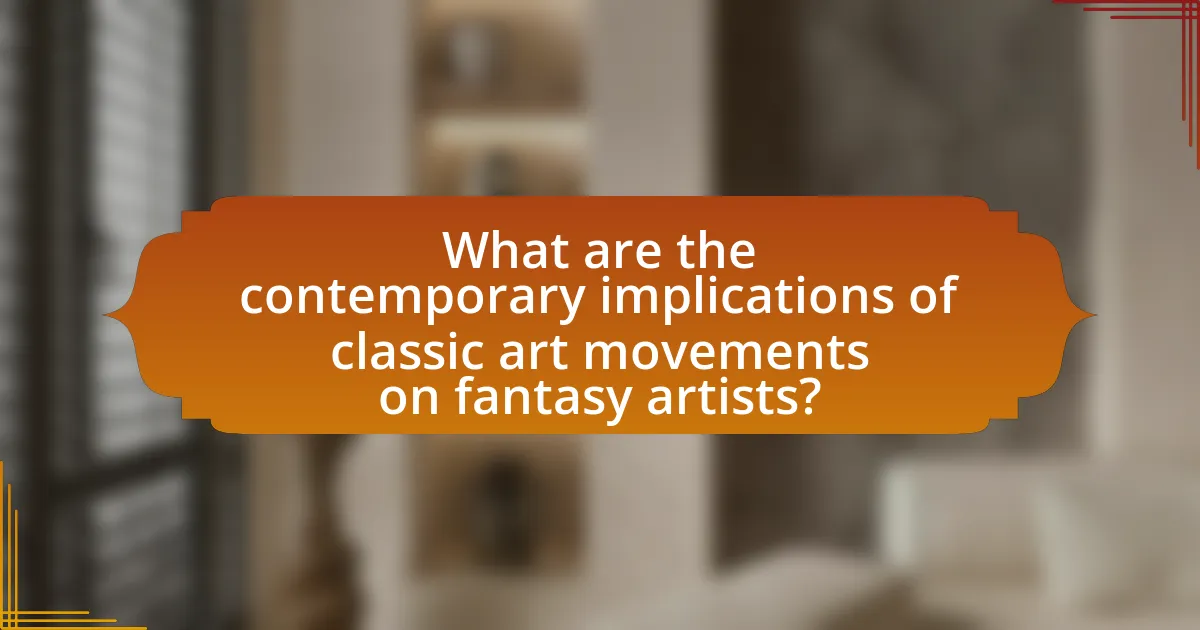
What are the contemporary implications of classic art movements on fantasy artists?
Contemporary implications of classic art movements on fantasy artists include the integration of techniques and themes from movements such as Romanticism, Surrealism, and Impressionism, which enhance the emotional depth and visual complexity of fantasy art. For instance, Romanticism’s emphasis on emotion and nature inspires fantasy artists to create immersive worlds that evoke strong feelings, while Surrealism’s dream-like imagery encourages the exploration of the subconscious, leading to innovative character designs and narratives. Additionally, Impressionism’s focus on light and color influences fantasy artists in their use of vibrant palettes and dynamic compositions, resulting in artworks that capture the viewer’s imagination. These movements provide a rich historical context that informs contemporary practices, allowing fantasy artists to draw upon established artistic principles to develop their unique styles.
How do modern fantasy artists reinterpret classic art styles?
Modern fantasy artists reinterpret classic art styles by blending traditional techniques with contemporary themes and narratives. For instance, artists often draw inspiration from the color palettes and composition methods of the Renaissance, infusing them with elements of fantasy such as mythical creatures and surreal landscapes. This approach not only pays homage to the masters like Michelangelo and Botticelli but also allows for innovative storytelling that resonates with today’s audiences. The use of digital tools further enhances this reinterpretation, enabling artists to experiment with textures and effects that were not possible in classic art, thus creating a unique fusion that reflects both historical influences and modern sensibilities.
What are some examples of fantasy artworks that reflect classic styles?
Examples of fantasy artworks that reflect classic styles include “The Garden of Earthly Delights” by Hieronymus Bosch, which showcases surreal and fantastical elements reminiscent of fantasy art, and “The Birth of Venus” by Sandro Botticelli, which combines mythological themes with classical aesthetics. Additionally, the works of artists like Frank Frazetta, who drew inspiration from classical painting techniques and themes, exemplify the fusion of fantasy with classic styles. These artworks demonstrate how classic art movements, such as the Renaissance and Baroque, have influenced contemporary fantasy artists in their use of composition, color, and thematic depth.
How do contemporary artists blend classic influences with modern techniques?
Contemporary artists blend classic influences with modern techniques by integrating traditional styles and themes into innovative mediums and practices. For instance, many artists draw inspiration from the techniques of the Renaissance, such as chiaroscuro and perspective, while employing digital tools like graphic design software to create new forms of art. This fusion allows for the preservation of historical aesthetics while pushing the boundaries of contemporary expression. A notable example is the work of Kehinde Wiley, who reinterprets classical portraiture by placing contemporary subjects in poses reminiscent of Old Master paintings, thereby merging historical context with modern identity.
What challenges do fantasy artists face when incorporating classic art influences?
Fantasy artists face several challenges when incorporating classic art influences, primarily due to the need to balance originality with historical fidelity. This challenge arises because classic art movements, such as the Renaissance or Baroque, have established techniques, themes, and aesthetics that can be difficult to reinterpret in a modern fantasy context. For instance, artists must navigate the risk of their work appearing derivative or lacking innovation while trying to honor the stylistic elements of classic art. Additionally, the integration of classic techniques, such as chiaroscuro or perspective, requires a deep understanding of these methods, which can be time-consuming to master. This complexity is compounded by the expectation from audiences for fantasy art to evoke a sense of wonder and imagination, which may conflict with the more rigid structures of classic art.
How do artists balance originality with homage to classic movements?
Artists balance originality with homage to classic movements by integrating contemporary techniques and personal expression while referencing established styles and themes. This approach allows artists to create unique works that resonate with historical significance, drawing inspiration from movements such as Impressionism or Surrealism. For instance, many modern fantasy artists utilize color palettes and compositional techniques reminiscent of the Old Masters, yet infuse their own narratives and styles, resulting in a fresh interpretation of classic elements. This method not only honors the past but also pushes the boundaries of creativity, exemplified by artists like Kehinde Wiley, who reinterprets classical portraiture through a modern lens.
What criticisms arise from the use of classic art influences in fantasy art?
Criticisms of classic art influences in fantasy art often center on the perceived lack of originality and the tendency to reinforce outdated stereotypes. Critics argue that reliance on classical styles can lead to derivative works that fail to innovate within the genre, limiting the potential for new artistic expressions. Additionally, some contend that classic art influences may perpetuate traditional gender roles and racial stereotypes, as many classical artworks reflect the biases of their time. This critique is supported by analyses of contemporary fantasy art that highlight how these influences can result in a homogenized aesthetic that does not adequately represent diverse narratives or perspectives.
What best practices can fantasy artists adopt from classic art movements?
Fantasy artists can adopt several best practices from classic art movements, including the use of composition techniques, color theory, and attention to detail. For instance, the Renaissance emphasized balanced compositions and the use of perspective, which can enhance the depth and realism in fantasy artwork. Additionally, the Impressionist movement’s focus on color harmony and light can inspire fantasy artists to create vibrant and dynamic scenes. Furthermore, the meticulous detail found in Baroque art can encourage artists to refine their techniques and enhance the intricacy of their designs. These practices are validated by the historical significance of these movements, which have shaped artistic standards and techniques over centuries.
